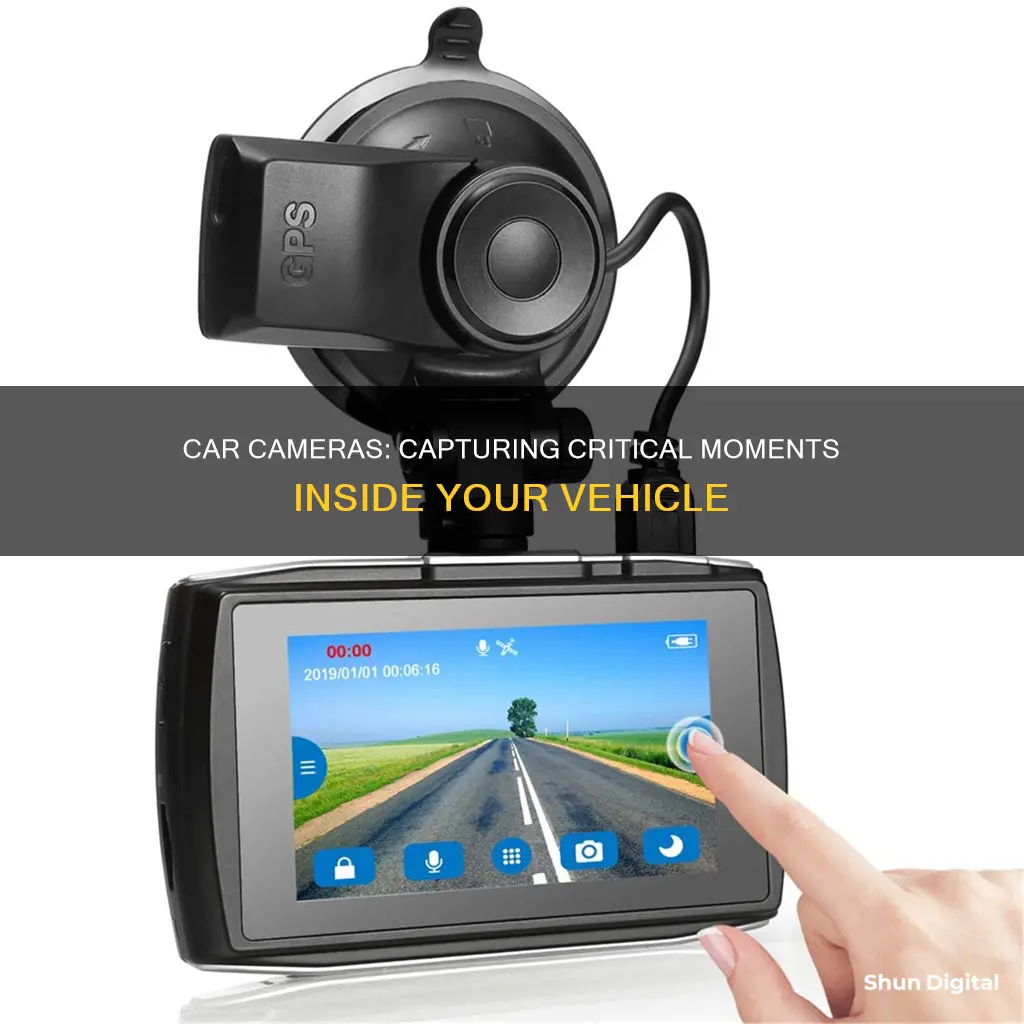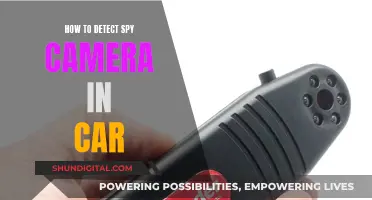
In-car cameras are becoming increasingly popular, with many new cars now being fitted with them as standard. There are several reasons why someone might want a camera inside their car, including to record any potential traffic incidents or accidents, to monitor the driver's awareness and behaviour, and to improve vehicle security. In-car cameras can also be used to provide a live feed to a smartphone or other device, which can be useful if you want to keep an eye on your car when it's parked or to check in on a new driver in the family. Additionally, some in-car cameras offer advanced features such as night vision, parking assistance, and driver assistance modes, which can be helpful for those who want more than just basic recording functionality.
| Characteristics | Values |
|---|---|
| Improve vehicle security | Monitor the inside and outside of the car when in motion or if activity is detected |
| Improve safety | Monitor driver's awareness and attention to the road |
| Improve convenience | Provide an enhanced bird's eye view of the vehicle's exterior |
| Enable autonomous driving | Enable the vehicle to see what's around it |
| Combat drunk driving | Analyze the driver's face and behavior |
| Reduce blind spots | Offer a clear view of blind spots on the digital dashboard |
| Improve suspension comfort | Tilt the car into corners for a smoother ride on and off-road |
| Ensure driver's eyes stay on the road | Track head movement |
| Record evidence in case of an accident | Record video and audio of the road and cabin |
What You'll Learn

To record break-ins when your car is parked
Having a camera inside your car can be a great way to record any break-ins when your car is parked. This can be a valuable security measure and help to deter thieves. There are a few different types of cameras that can be used for this purpose, each with its own advantages and disadvantages.
Dual dash cameras
Dual dash cameras record from the front and the back of your car, giving you a complete view of everything happening around your vehicle. They are also small and discreet, so they easily go unnoticed. The drawback of dual dash cams is that they usually stop working as soon as the car engine is turned off, which may not be ideal if you want to record break-ins when your car is parked.
Interior dash cams
An interior dash cam records footage of your car's interior, giving you a clear view of everything happening in the cabin. This can be useful for recording any accidents or incidents while driving, and can also be beneficial if you need to file an insurance claim. Interior dash cams are also a good option for recording break-ins, as they will continue to record even when the car is turned off.
Professional car security cameras
A professional car security camera or security camera system is the best option for monitoring your parked car. These cameras typically come with features like motion detection and night vision, so they can provide continuous surveillance even when you're not around. The camera systems also come with multiple cameras that cover all angles, so anyone trying to break into your vehicle will be caught on video.
When choosing a camera to record break-ins when your car is parked, it is important to consider the power supply, internet connectivity, placement, night vision capabilities, and motion detection features. It is also crucial to ensure that the camera has a parking mode, which allows it to keep working even when the vehicle is turned off.
Focusing Your Camera on Snapchat: A Quick Guide
You may want to see also

To monitor your driving habits
An interior car camera can be used to monitor your driving habits. This can be useful for tracking your own driving, or for monitoring the driving habits of another person driving your car, such as a new or inexperienced driver.
A camera can provide an objective record of a journey, which can be useful in the event of an accident or incident. This can be used as evidence to prove your innocence to a lawyer, insurance company, or law enforcement. It can also be used to monitor unsafe driving and help improve driving skills.
Some cameras have additional features that can aid drivers, such as alerts for nearby speed cameras and red-light cameras, and prompts to tell you when the vehicle in front has set off.
There are also more advanced features available, such as voice control, Alexa support, and emergency alerts.
Car Mode: How Your Camera Adapts for Clearer Photos
You may want to see also

To improve vehicle security
A camera inside your car can be an effective way to improve vehicle security. There are several types of cameras available for this purpose, each with its own advantages and features.
Dual Dash Cameras
Dual dash cameras record from both the front and the back of your car, giving you a complete view of everything happening around your vehicle. They are also small and discreet, so they can easily go unnoticed. The main drawback of dual dash cams is that they usually stop working as soon as the car engine is turned off.
Interior Dash Cams
An interior dash cam records footage of your car's interior, allowing you to monitor the cabin and keep an eye on passengers. This can be useful for ensuring safety and can also help in recording any accidents or incidents while driving, which can be beneficial for insurance claims.
Professional Car Security Cameras
Professional car security cameras or security camera systems typically offer features such as motion detection and night vision, ensuring your car is protected even when you're not around. These systems often include multiple cameras that cover all angles, so anyone attempting to break into your vehicle will be caught on video.
When choosing a camera system for vehicle security, consider factors such as power supply, internet connectivity, placement, night vision capabilities, and motion detection. Additionally, look for cameras with clear footage quality that can be used as evidence in the event of a crime or insurance claim.
Manual Mode for the S8 Plus Camera: Where is it?
You may want to see also

To provide evidence in the event of a road accident
A camera inside your car can be a very useful tool for proving liability if you're involved in a car accident. It can be challenging to prove liability for a car crash, and dashcam footage can provide strong evidence to support your claim for compensation. This evidence can be used to clarify who is liable for damages and can be especially useful in complicated car crash cases.
Dashcams can record what occurs in front of you and, in some cases, inside your car as well. This footage can be used to show that you were driving within the posted speed limit, driving straight ahead in your lane, or that another driver hit you. It can also capture the events after a collision, such as the other driver's apology or hostility, which can help confirm that individual's negligence caused the crash.
Additionally, dashcam footage is often timestamped, which makes it even more valuable as evidence. This timestamp can provide enough proof for an insurance company to settle your claim without a trial. It can also be used as leverage by your attorney when negotiating for a settlement, as it is hard evidence that even the at-fault driver's insurer would have a difficult time challenging.
However, it's important to note that dashcam footage can also be used against you. For example, if you contributed to the accident, the footage could be used by the other party to prove your liability. It's also possible that the footage is inconclusive, altered, or doesn't capture the collision, which could make it less useful for your case.
Plastic Camera Covers: Are Toyota Cars Equipped?
You may want to see also

To monitor driver behaviour and attention
One of the most recent advancements in vehicle safety is the driver attention warning system. This technology is essential for preventing accidents caused by drowsy driving. The system actively monitors the driver's eye position and head movements, identifying signs of fatigue or lack of attention. When the system detects indicators of drowsiness or distraction, it promptly alerts the driver to ensure their focus remains on the road.
The Driver Monitoring System (DMS), also known as the driver attention monitor, is a camera-based technology that assesses the driver's alertness and warns them if needed. The system not only recognizes the driver, but also checks their level of vigilance to increase safety for passengers and other road users.
The vehicle is equipped with a camera built into the dashboard that's focused on the driver's face. This allows for functionalities such as:
- Identification of the driver so the vehicle can automatically restore their preferences and settings.
- Monitoring driver fatigue and alerting them when it detects drowsiness.
- Monitoring driver attentiveness and ensuring they keep their eyes on the road and remain aware of any dangerous situations.
The DMS uses infrared sensors to monitor driver attentiveness. Specifically, the system includes a CCD camera placed on the steering column that tracks the face via infrared LED detectors. If the driver is not paying attention to the road ahead and a dangerous situation is detected, the system will warn the driver through flashing lights and warning sounds. If no action is taken, the vehicle will apply the brakes.
- Honda Driver Attention Monitor: The angle sensor monitors the degree of driver steering-wheel corrections to keep a stable lane position. It will notify the driver if it detects excessive correction activity and will display a message informing them to take a break. If the detected level of attention worsens, the system will produce a more noticeable visual warning, an audio alert, and vibrate the steering wheel to encourage driver attention.
- Toyota Driver Attention Monitor: The driver's eyes are monitored by an infrared light source and camera to determine where the driver is looking. It accounts for how long they look there and signs of lane departure or wandering in the vehicle's travel path. If a potential problem is detected, both audible warning sounds (beeps) and visual warning messages are displayed. The driver's attention monitor may be configured to give a driver attention alert and sound an alarm when the driver is looking away from the road for more than three seconds or if other potentially dangerous driving behavior occurs.
- Ford Driver Alert Monitor: This system uses a forward-facing camera mounted in the instrument cluster to detect whether the driver's eyes are open or closed and in which direction they are looking. The system can determine whether a driver is too close to an object ahead to brake safely. If the driver doesn't respond after multiple alerts, Ford's Adaptive Cruise Control with Collision Warning will automatically engage emergency braking to help avoid or reduce impact.
Driver attention warning systems are becoming more common in U.S. passenger vehicles. This technology is crucial for road safety as it addresses one of the primary causes of accidents: driver inattention.
Best Car Camera Reviews: Our Top Picks Compared
You may want to see also







